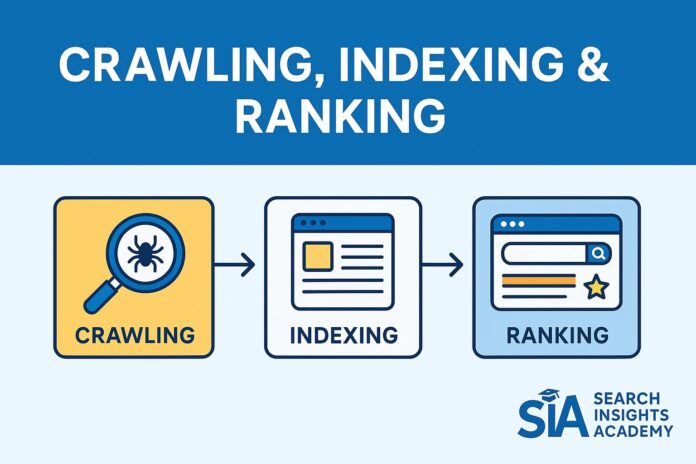Have you ever wondered why some websites pop up instantly on Google while others seem to be stuck on page two, three, or even further back? Do you sometimes feel lost trying to figure out the exact keywords to use for your audience, or do you just want a clearer grasp of where to start with SEO? These are the questions we’ll explore right here. You’ll soon discover how choosing the right target terms can make a huge difference to your brand’s visibility and overall success online.
In this post, we’ll dig into the foundations of keyword research and look at why it’s absolutely key to success in this modern digital sphere. We’ll discuss essential categories—like Low Hanging Fruit Keywords, High Traffic Keywords, and Achievable Difficulty Keywords—along with the best tools to streamline your search process. We’ll also talk about how to adapt your approach for location-specific terms, whether you’re targeting local customers in Sydney or serving clients in New York.
By the end, you’ll have a practical roadmap for “how to do keyword research,” and you’ll know exactly what steps to take next. From mastering “initial keyword research” to harnessing advanced methods like “expert keyword research,” this guide aims to walk you through each stage. So, if you want to ensure your site stands out and drives the right kind of traffic, keep reading. Let’s begin this journey towards clearer, more effective keyword research strategies that truly work.
Introduction to Keyword Research
Why Keyword Research Matters
Keyword research is the cornerstone of any good SEO strategy. It’s the process of investigating which words or phrases people type into Google—or other search engines—when they’re looking for information. By finding these specific terms, you can create content that directly addresses your audience’s questions and needs. When done thoroughly, keyword research can improve your organic visibility by 50% or more, and ultimately lead to better conversions.
These keywords work as pathways that connect your products or services with potential customers. They’re more than just search terms; they embody user intent. In other words, a phrase like “keywords meaning in research” represents someone who’s trying to understand the concept of targeted terms. By shaping your content around these ideas, you position yourself to match that user’s needs right from the start.
On top of that, strong keyword research helps you stay ahead of competitors. When you figure out how to research keywords in a strategic way, you can discover hidden gems that others have overlooked. Whether you’re analyzing historical data or looking at the broader scope of keyword searching, the right approach can keep you on the cutting edge.
Common SEO Challenges for Websites
Websites around the world face several common hurdles. First off, there’s the challenge of targeting the right audience. Many businesses aim to attract both local and global visitors, so choosing keywords that resonate with your specific market while still appealing to broader audiences can be tricky. For instance, niche-specific terminology might work well for specialized businesses, yet more general terms are often saturated with competition.
Another challenge relates to language variations and locale-specific terms. English spellings can differ between regions (like “optimization” versus “optimisation”), which can influence ranking if your audience typically uses one form over another. Additionally, local expressions or jargon might require different keyword strategies. By conducting thorough keyword analysis, you can refine how you incorporate these terms on your site.
Lastly, economic factors and regional buyer behaviors can impact how people search and what convinces them to convert. That’s why businesses sometimes need to focus on niche or quick-win keywords that are easier to rank for in their target markets. Having an initial keyword research plan tailored to specific markets can save time, reduce costs, and attract ready-to-buy customers.
Defining Keywords: “What Is Keyword?” and “Keywords Meaning in Research”
A “keyword” is essentially any word or phrase that people use when searching online. It could be as short as “coffee” or as detailed as “best coffee shop near me that offers oat milk alternatives.” Knowing what a keyword is sets the tone for everything else in your SEO strategy. When you grasp keywords’ meaning in research, you start to see them not just as random phrases but as clue-filled insights into user behavior, pain points, and interests.
The real power of keywords comes from alignment. When your site’s content and SEO strategy perfectly match what people are typing into Google, you’re far more likely to show up front and center. This is why keyword analysis reveals so much—it gives you a snapshot of what’s performing, what’s failing, and what your competitors are targeting. That way, you can tailor content that hits the mark every time.
Understanding Keyword Categories
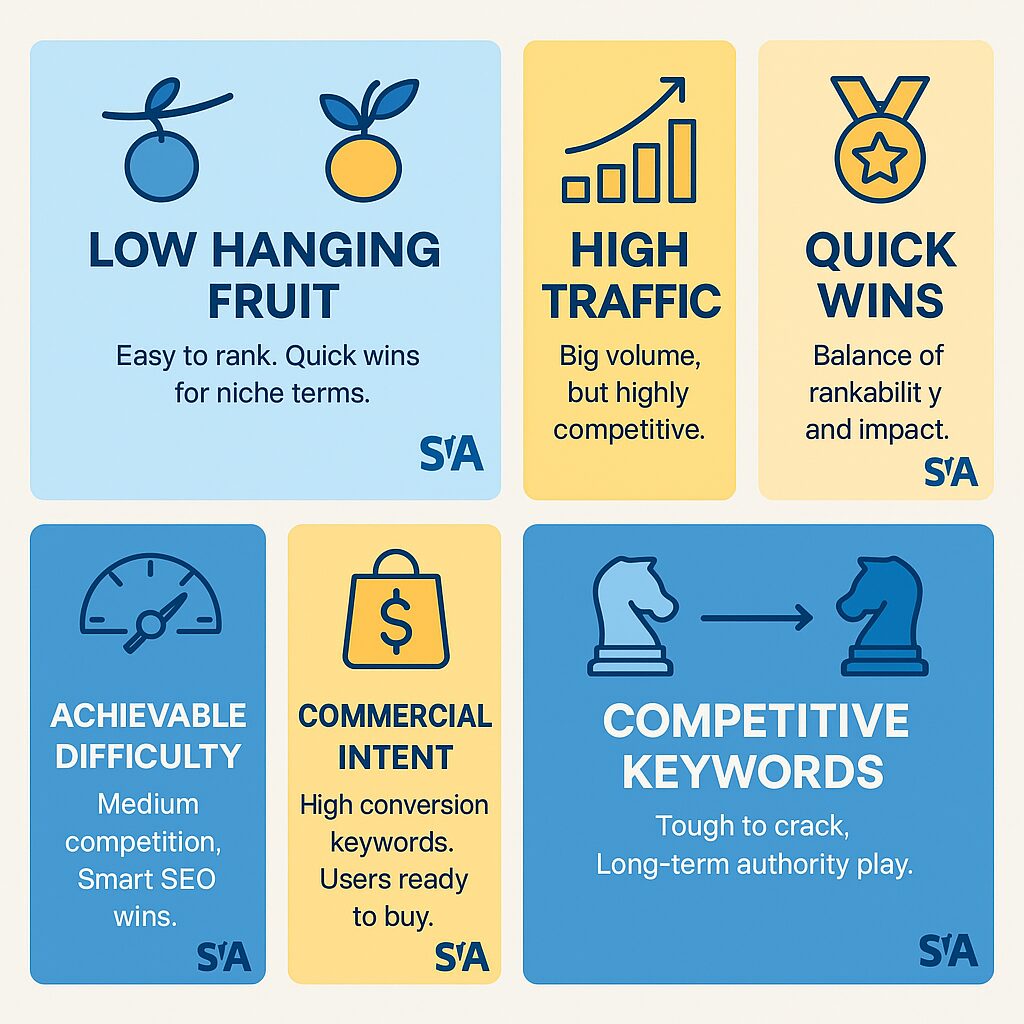
Low Hanging Fruit Keywords
“Low Hanging Fruit Keywords” are your quick wins. They’re those search terms that might not have massive search volume but are relatively simple to rank for. This category often includes phrases like “specialist coffee brewing tips” or long-tail queries such as “initial keyword research for small business.” Because the competition for these is lower, it doesn’t take a massive campaign to see results. You might only need a well-optimized blog post or a few strategic backlinks to boost your ranking.
One helpful approach to unearthing these easily achievable terms is checking your analytics data for queries you’re already starting to rank for. If you notice that you appear on page two or three for certain topics, adding extra content or refining your metadata might push you to page one. Tools like Google Search Console can reveal a wealth of information about these near-successes.
Additionally, consider the user’s mindset: “Low Hanging Fruit Keywords” often indicate a more specific intent. Someone typing “seo keywords for portfolio websites” might be focusing on platform-specific tactics, meaning they’re likely in a narrower segment of your target audience. By serving up well-researched content for these users, you build trust and authority, positioning your site as a go-to resource.
High Traffic Keywords
High Traffic Keywords can bring in crowds, but they also come with stiff competition. Phrases like “keyword research 2023” and “how to use ahrefs for keyword research” often attract large volumes of monthly searches. Everyone from multinational brands to local shops may be trying to rank for these. It means you’ll likely need a more robust approach—strong link-building, professional content creation, and possibly a bigger marketing budget—to stand a chance.
If you’re aiming for these terms, it’s vital to align your content with the user’s expectations. People searching “how to do keyword research” may want a step-by-step guide, while someone typing “keyword searching” could be open to a range of how-to advice or best practice tips. By analyzing search intent, you can craft the right content to meet their needs.
Remember that High Traffic Keywords often sit within what some call “head terms” or “short-tail keywords.” These are broad phrases like “keyword research” or “keywords,” which attract massive interest. Balancing these with more focused, long-tail keywords can help spread your SEO risk. If it’s too hard to rank for “google keyword,” you might try a variation such as “google adwords keyword search” that fits your site more precisely.
Quick Wins Keywords
Quick Wins Keywords occupy a middle ground between Low Hanging Fruit and High Traffic Keywords. They still offer the opportunity for faster improvements in rankings, but they tend to have higher search volumes than simple low-hanging terms. Because of this balance, they can quickly boost your site’s visibility without requiring an all-consuming SEO campaign.
When identifying Quick Wins Keywords, look for terms that have enough monthly searches to make a difference but aren’t dominated by large competitors. You’ll often find these in niche-specific queries like “how to research keywords” for a particular industry. By producing valuable, straightforward content that answers these questions, you can climb the rankings at a decent speed.
Also, check your site’s existing performance data. If you’re already ranking in the top 20 for certain phrases with little effort, giving those pages a refresh or adding relevant internal links might nudge you into the top 10. Research shows that updating existing content can increase organic traffic by 106%. The key is to maintain a laser focus on user needs. When your content is complete and user-centered, you’ll stand out more—even for moderately competitive terms.
High Volume Keywords
High Volume Keywords differ slightly from High Traffic Keywords but are often related. While “High Traffic” emphasizes how many users are drawn in, “High Volume” refers directly to the monthly search numbers. Terms like “keyword research” or “google keyword search” could pull in thousands of users each month, but these phrases might be vague. You need to be sure you can meet the broad interests attached to them.
In many cases, ranking for High Volume Keywords provides a shot at big returns. Even a fraction of those searches can result in more leads than a smaller-volume term. However, be careful: intense competition and the potential for high bounce rates exist if the keyword is too general or if your content doesn’t match what users actually want.
Always consider your own capabilities. You might want to pair High Volume Keywords with well-researched, niche-friendly angles. For instance, you could turn “google keyword analysis” into a comprehensive blog series. That kind of robust content, combined with targeted link-building, helps you position your brand without wasting resources on overly broad terms that never convert.
Achievable Difficulty Keywords
“Achievable Difficulty Keywords” walk the fine line between moderate competition and decent traffic. Think of them as the sweet spot—challenging but absolutely possible to rank for if you apply the right strategy. Examples might include specific industry terms, “google keyword research for beginners,” or “how to do a keyword search for e-commerce,” depending on the strength of your domain and the quality of your content.
Achievable Difficulty Keywords often require some SEO know-how—on-page optimization, technical fine-tuning, and maybe a few backlinks from relevant sites. They’re not a cakewalk, but they’re far from impossible. By targeting these terms, you can build your site’s authority gradually. Each time you secure a top-10 spot for an Achievable Difficulty Keyword, your credibility grows, making it easier to rank for even tougher phrases down the road.
To find these opportunities, consult specialized SEO tools. For instance, keyword analysis tools or paid platforms like Ahrefs can show you which terms strike this balance of difficulty and volume. Then, focus on building content or landing pages that specifically resolve the queries behind these topics. Over time, you’ll see your rankings climb, proving that strategic targeting really does pay off.
Commercial Intent Keywords
Commercial Intent Keywords are designed to convert. Think “buy,” “pricing,” or “services” attached to your core products. Although not explicitly spelled out in our earlier lists, they function similarly to terms like “keyword SEO tools,” or “SEO keyword research services” when users are actively seeking paid tools or professional services. People searching these have typically done preliminary research and now want a solution.
When incorporating Commercial Intent Keywords, ensure your pages clearly describe what you offer, why it’s beneficial, and how users can take immediate action (like buying or booking). Simple language, strong calls to action, and user-friendly design are essential. After all, if someone types “what is keyword SEO?” you can bet they’re looking to either learn the basics or find a professional to help them.
Commercial Intent Keywords might not bring huge traffic, but they can deliver high-quality leads, which means better ROI. So don’t neglect them. Research indicates that commercial intent keywords convert at 10x the rate of informational keywords. Use them on product pages, in meta descriptions, and within on-site copy to attract visitors who are ready to do business.
Competitive Keywords
Competitive Keywords pit you against larger players who’ve already carved out a strong foothold. Terms like “keyword searching,” “seo keyword,” and “seo keyword research” can be fiercely contested. If you’re a smaller or newer site, you might find these tough to tackle early on. However, ignoring them entirely could limit your long-term growth.
One possible approach is to create “cornerstone content.” This is extensive, high-quality content that thoroughly covers a topic—from basics to advanced tactics. Over time, as you gain backlinks and user trust, your “keyword search SEO” or “SEO keyword analysis” articles might start to climb. You can also consider a blended strategy: target smaller, related keywords first, then slowly incorporate more challenging ones.
When entering the competitive arena, patience and consistent effort are your best friends. According to SEO experts, regularly updating your content, refining your site structure, and ensuring a smooth user experience are key differentiators. Ultimately, even the most competitive phrases can become within reach once your site gains authority and recognition.
Essential Tools & Techniques
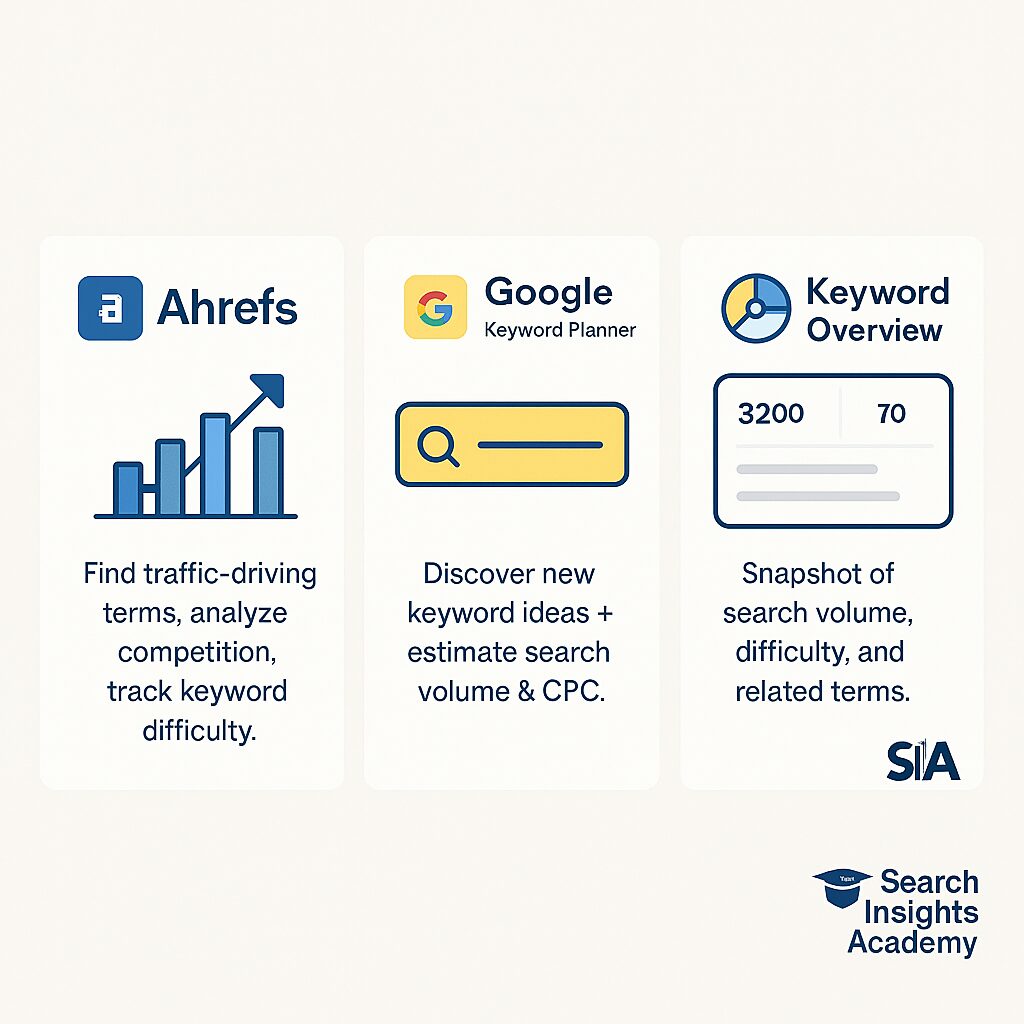
“Keyword Overview Allows You To…”
Most SEO tools include a feature commonly labeled “Keyword Overview.” Whether it’s free or paid, keyword overview allows you to quickly see critical data: monthly search volume, competition level, and even related terms you may have overlooked. This snapshot paints a clear picture of how worthwhile a keyword is.
Using a keyword overview can help turn guesswork into certainty. Instead of speculating about which terms might perform well, you can rely on actual data. Seeing metrics such as cost-per-click (CPC) can also help you decide if certain Commercial Intent Keywords are profitable enough to invest in.
Start applying this technique to your initial keyword research. If, for example, you discover that “expert keyword research” has a steadily growing monthly volume and moderate competition, that might signal a savvy opportunity for new blog posts or product offerings. The best part? Many tools let you export and sort data so you can compare your target terms side by side.
“How to Use Ahrefs for Keyword Research?”
If you’ve been wondering how to use Ahrefs for keyword research, you’ll be pleased to learn it’s simpler than it sounds. Once you open Ahrefs’ Keywords Explorer, enter terms like “google adwords keyword search” or “keyword research tools.” Then, you’ll see niche insights: difficulty scores, potential traffic, and a list of related queries.
Ahrefs excels in competitor analysis too. You can find out which keywords drive the most traffic to rival sites—perhaps “how to do keyword research for social media”—and tailor your strategy accordingly. This can unearth hidden gems that other sites haven’t locked down.
To get the most out of Ahrefs, keep an eye on the “keyword difficulty” metric. Terms below a certain threshold are more achievable, especially if your domain authority is still growing. Ahrefs’ official tutorial combines that with a decent search volume, and you’ve got a stellar candidate for your content plan.
Google Ads Keyword Search & Planner
Google Ads Keyword Planner is another heavyweight in the research game. It was originally built for advertisers, but it’s still a top-notch tool for organic SEO. By plugging in words like “keyword searching” or “how to keyword research,” you’ll get a range of suggestions alongside monthly search estimates. It can also reveal how competitive the bidding environment is, giving you a peek into which terms have potential commercial appeal.
When you integrate data from Google Ads Keyword Planner, you’ll gain an extra layer of clarity. For instance, if you notice that “google keyword analysis” is highly competitive in the ad space, it likely means that many businesses see profit in ranking for it. You can then decide if it’s worth your efforts to compete or if you’d be wiser to shift focus to less saturated options.
Make sure you use location filters if you’re targeting specific regions. This will show you regionally-specific data, which is particularly useful for local industries or services. As the Google Ads Help Center explains, the more precise your targeting, the more relevant your traffic becomes, boosting your chances of turning casual visitors into loyal customers.
Expanding Your Reach: “Expert Keyword Research” Methods
Beyond the basics, “expert keyword research” methods involve a bit of creativity. For example, comb through Facebook groups and Twitter threads relevant to your niche—these are goldmines for discovering the exact words and phrases people use. If someone’s asking, “How do you do keyword research for a new online store?” that might become an entire blog topic.
You can also look into voice search trends, which often feature conversational terms. Think “How do you do keyword research on mobile?” or “What is the best way to do a keyword search in 2023?” People often phrase voice queries differently, leaning on natural language. Studies show that 71% of consumers prefer voice searches over typing, making this an essential area to explore. Capturing these phrases can set you apart from competitors who ignore voice-based patterns.
Finally, keep an eye on emerging niches. New technologies or changing consumer behaviors can birth fresh search terms overnight. By catching these early, your site gains a first-mover advantage, letting you rank high before the competition even notices.
Analysing & Prioritising Your Keyword List
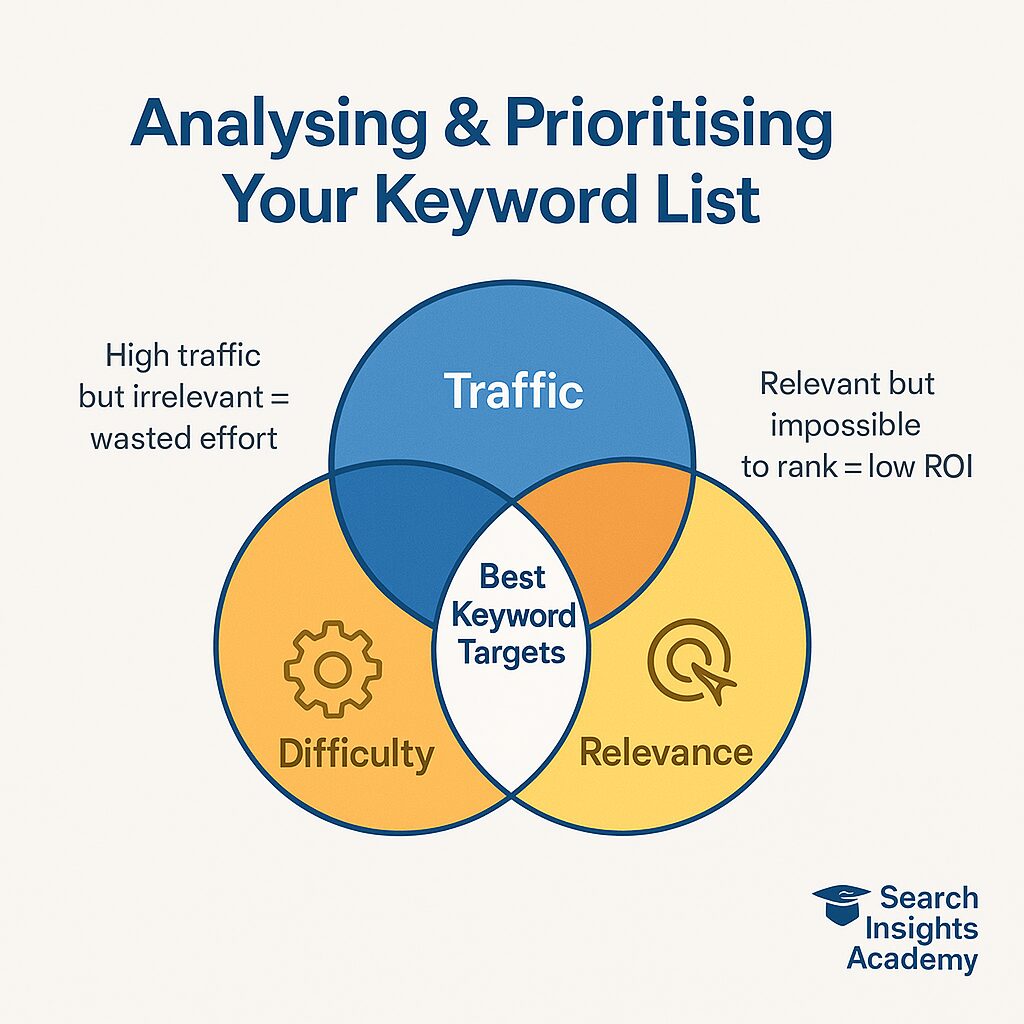
Evaluating Traffic, Difficulty, and Relevance
Once you’ve shortlisted potential terms, the next step is to evaluate traffic, difficulty, and relevance. Tools like Ahrefs or Moz show estimated difficulty scores, helping you judge how much effort it’ll take to rank for “how to do a keyword search.” Combined with search volume, these metrics reveal whether a keyword is a worthy investment of your time and resources.
However, don’t chase volume blindly. A term that draws thousands of monthly searches might be useless if it doesn’t match what you offer or if it’s nearly impossible to rank for. Relevance is crucial—there’s no point ranking for “coffee shop deals” if you’re an IT consultancy. Examine each keyword’s intent by checking the search results. If the top sites look similar to yours, you’re probably on the right track.
Keep a simple spreadsheet of your findings. According to content marketing experts, assigning each keyword a priority level (high, medium, or low) based on how well it aligns with your goals ensures you devote time to the terms that truly matter, whether they’re “seo keyword analysis” or “initial keyword research.”
“How to Do Keyword Analysis?”
Ask any SEO pro, “How to do keyword analysis?” and the process often boils down to understanding patterns in the data. You start by gathering all potential keywords—from “keywords meaning in research” to sophisticated phrases like “google keyword research.” Then you clean up duplicates, group similar queries, and check metrics such as search volume, difficulty, and commercial intent.
At this stage, it’s also wise to gauge the competition. Search your top terms on Google to see which pages rank highest. If those pages have strong backlinks, a high domain authority, or exceptional content, ranking above them will take more work. Conversely, if you notice outdated or poorly structured content in the top results, you may have a prime opportunity for better rankings.
Finally, segment your keywords into categories—like we discussed earlier—to organize your plan. A study by SEMrush found that a mixture of Low Hanging Fruit, High Volume, and Achievable Difficulty Keywords can give you a balanced approach. That way, you secure short-term results while also setting up for bigger wins down the line.
Making Sense of “Keyword Analysis Google”
“Keyword Analysis Google” is a phrase people often search when they want quick instructions or effective tips for using Google’s platforms. The idea is to see which queries are currently gaining traction and to find patterns in how people phrase their searches. It could be as simple as tracking monthly trends in Google Trends to see when “how to do keyword research” queries spike.
What’s more, Google’s autocomplete suggestions can also provide valuable insights. If you start typing “how to do key…” and see suggestions like “how to do keyword analysis for a blog,” you know that’s a query people regularly type in. This direct-from-Google approach can bring real-time data, which is especially handy if you’re writing about fast-changing topics.
Ultimately, making sense of “keyword analysis google” is about layering different data sources. Check Google Search Console for performance details, use Google Keyword Planner for volume statistics, and keep an eye on autocomplete for emerging phrases. Combined, these insights form a powerhouse approach to refining your keyword strategy.
Aligning Keywords with User Intent
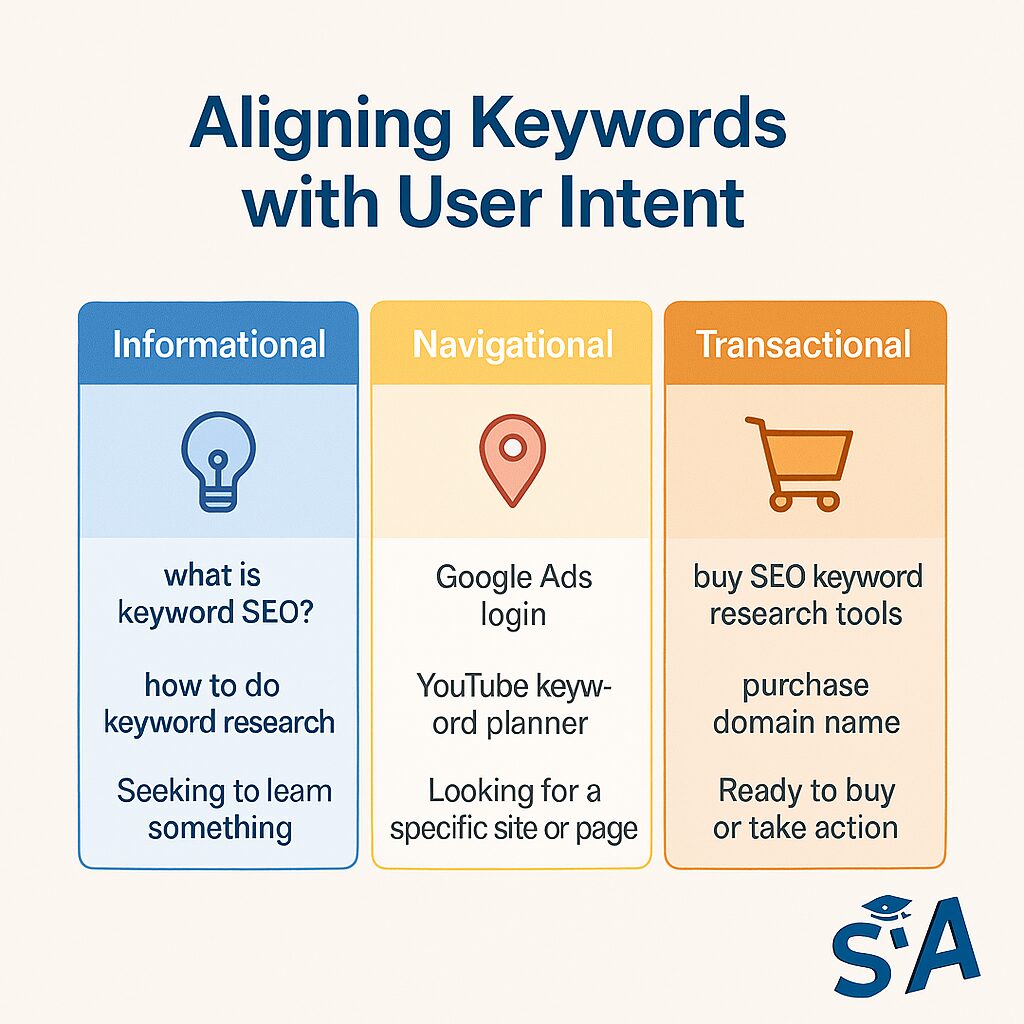
User intent is the hidden secret behind every successful keyword. Even if a phrase like “how to do keyword analysis” has a high search volume, it’s useless if the intent doesn’t match the content on your page. Ask yourself: Are they looking for a how-to guide, a paid tool, or just a definition?
For instance, someone searching “what is keyword SEO?” might only want an overview, so a detailed tutorial might be too in-depth. Conversely, if someone types, “how to research keywords for an e-commerce website,” they’re likely in need of step-by-step instructions. Aligning these nuances with your content ensures visitors stick around, read through, and hopefully convert.
When you nail user intent, you’ll see lower bounce rates, more time on page, and better conversions. According to Search Engine Journal, it’s not just about pleasing an algorithm; it’s about serving real people. The result is a positive user experience that can also boost your SEO rankings in the long run.
Localising Your Approach
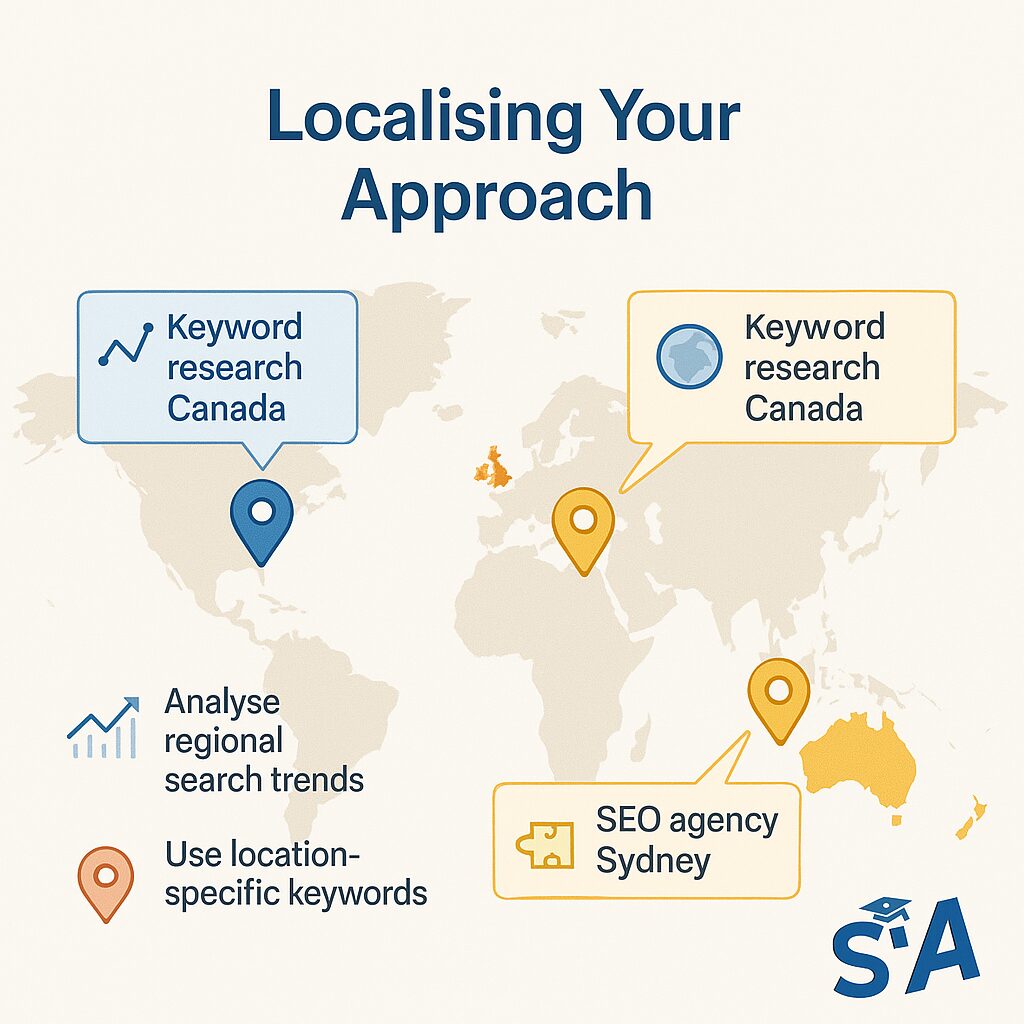
Researching Regional Search Trends
Different regions have their own unique search trends. Sometimes, these differ from global patterns—especially when factoring in holiday seasons, sporting events, or local culture. To adapt, configure your keyword tools to filter data by location. Then pay attention to local events or news that might cause spikes in specific searches.
Seasonal changes can also influence regional search behavior. For instance, if you notice more “how do you do keyword research” queries during certain months in the UK versus the US, you might capitalize on that by publishing new content or offering a workshop during peak interest times. Research from BrightEdge shows that tailoring your approach in this way makes your content feel more relevant to local readers.
Moreover, check local search volume for phrases like “seo keywords for business websites.” Though it might have global interest, the regional slice could behave differently. By refining your content to reflect local tastes—like referencing regional brands or including specific shipping details—you increase the chance of conversions from that area.
Leveraging Location-Specific Terms
Location-specific keywords might include the city, state, country, or region you’re targeting. For a New York-based bakery, phrases like “best sourdough in Manhattan” could be a goldmine. Though fewer people might search such a term globally, those who do are highly likely to be potential customers nearby.
One popular tactic is to create location-specific landing pages. Let’s say you have multiple store branches across different cities. You could build separate pages optimized for “bakery in Chicago,” “bakery in London,” and so forth. Each page can highlight local elements, like store hours, local news, or community partnerships.
You can also weave these location terms into blog posts or FAQ sections. For instance, if someone searches “how to do a keyword search for businesses in Canada,” a well-crafted post covering Canada-specific SEO tips might be just the ticket. Google’s own guidelines recommend that the more you integrate local context, the more you’ll stand out to search engines and users looking for regionally relevant information.
FAQs and Common Pitfalls
“How to Do Keyword Research?”
One of the most common questions is simply “How to do keyword research?” The short answer is: brainstorm relevant topics, use SEO tools to identify promising terms, and analyze metrics like search volume and competition. Start with straightforward phrases—like “keyword research,” “how to keyword research,” or “researching keywords.” Then refine your list by checking how competitive each one is.
Make sure you don’t overlook user intent. People who want to learn “how to do keyword research” aren’t necessarily ready to buy an SEO service. So your content should inform, guide, and possibly lead them to explore more advanced or commercial pages on your site. According to Backlinko’s research, this approach builds trust and credibility.
“How to Do a Keyword Search?” and “How Do You Do Keyword Research?”
“How to do a keyword search?” and “How do you do keyword research?” are often used interchangeably, but they can hint at different intentions. “How to do a keyword search?” may indicate someone who wants a basic introduction, possibly for a personal blog or a small community site. “How do you do keyword research?” suggests they might be new to SEO but are starting to look for more detailed methods and tools.
A best-practice tip is to create content that covers both the beginner’s perspective and a step-up in complexity. Offer a quick, simple explanation alongside a more detailed, advanced outline. SEO experts at Moz recommend this dual-layer approach ensures you’re addressing everyone—whether they need an entry-level guide or something more comprehensive.
“How to Keyword Research?”
Yet another variation is “how to keyword research?” While the phrase might seem grammatically clumsy, it’s a real query people type into Google. Embrace these slight variations by weaving them naturally into your headings or body copy. You could label a subheading “How to Keyword Research for E-commerce” to address that exact question while providing relevant context.
Responding to such specific queries is a strong SEO tactic. According to HubSpot, it signals to Google that your content directly answers what users ask for. Over time, your pages might appear in featured snippets or rank higher, thanks to this precise alignment with search terms.
“What Is Keyword SEO?”
Lastly, “what is keyword SEO?” is where many newcomers start. This question often implies they’re uncertain about how SEO and keywords interlink. A good response explains that keywords serve as the blueprint for your SEO strategy. They are the words and phrases that connect your content to a user’s search query.
Make it clear that high-quality content remains vital. Even the most strategic list of keywords won’t help if your content doesn’t provide real value. Search Engine Watch reports that you should encourage readers to see “keyword SEO” as an ongoing process: discovering new terms, updating existing pages, and continually measuring performance.
Creating a Sustainable Keyword Strategy
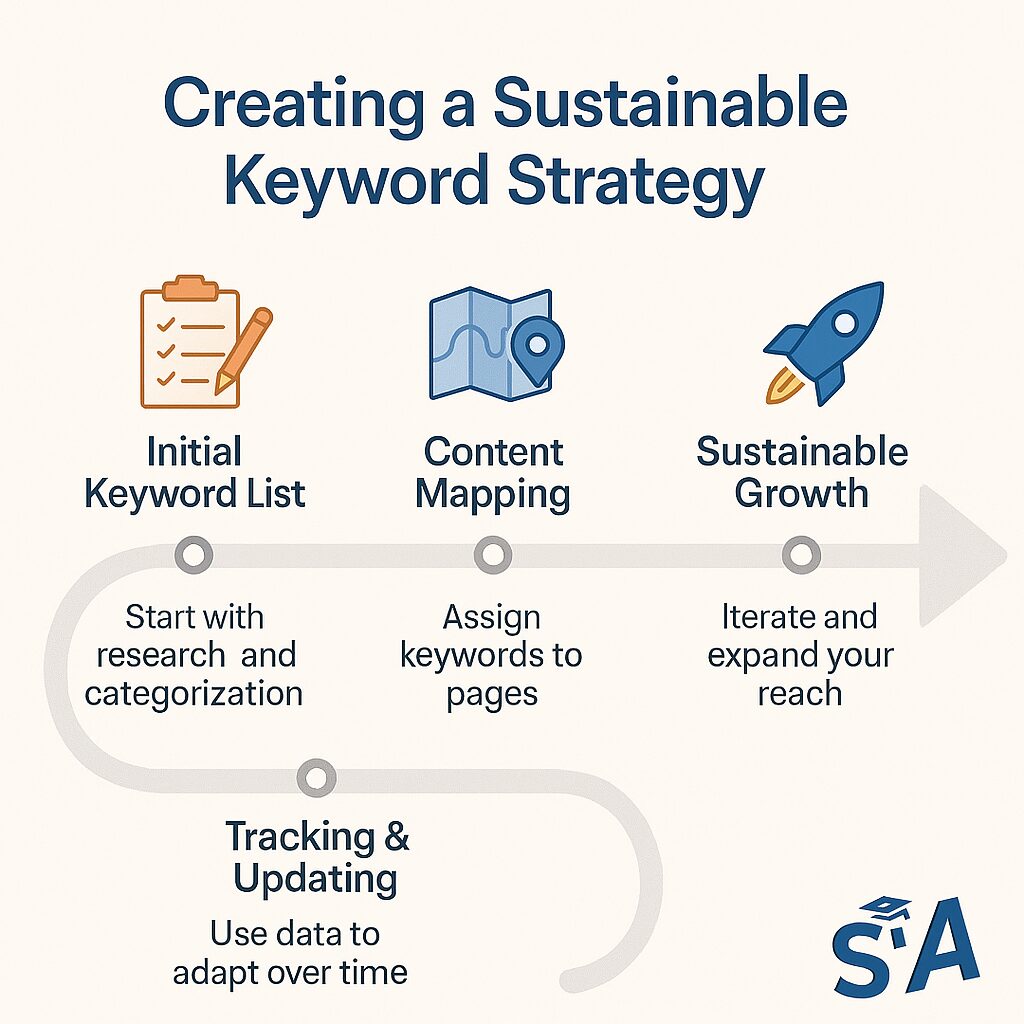
Building Your Long-Term Keyword Plan
A sustainable keyword plan is all about balance. You’ll want a mix of short-term wins—through Low Hanging Fruit Keywords—and long-term goals, such as tackling more competitive phrases like “keyword SEO” or “seo and keyword search.” Start by listing the terms you can realistically aim for right now, and then gradually expand into bigger challenges.
Don’t forget to map these keywords to specific pages or blogs. That way, you avoid duplicating efforts or cannibalizing your keyword potential. Content marketing studies show that a central spreadsheet or project management tool can help you keep track of what’s been published, what needs revising, and what’s coming next.
As you gain traction, revisit your research. Trends evolve. People’s search behavior changes. Words that were overlooked might become the next “keyword research search” trend. Keep an eye on your analytics to spot any shifts, and adapt your plan accordingly.
Ongoing Tracking and Adaptation
SEO is not a one-and-done activity. Tracking performance is a must—monitor your rankings, organic traffic, and engagement rates. If you spot that a certain page is slipping in rankings, re-optimize it. Perhaps your content is out of date or your competition has published something more relevant.
Set monthly or quarterly check-ins to review your strategy. Tools like Google Search Console will let you see which queries drive the most clicks. If, for example, “researching keywords” is bringing in more traffic than expected, you might create additional articles or videos that address similar queries.
Finally, celebrate small wins. Each time you move up a few positions for a challenging keyword or notice an uptick in conversions from a commercial term, you’re inching closer to your goals. Experts at Search Engine Land emphasize the importance of staying flexible, keep learning, and never shy away from experimenting with new techniques to refine your sustainable keyword strategy.
Next Steps
Have you noticed that the key to keyword research isn’t just about piling up random words but about connecting authentically with your audience’s questions and needs? That’s the big takeaway here. In today’s competitive market—whether you’re in Sydney, London, New York, or anywhere else—an effective keyword strategy helps you stand out, drive relevant traffic, and build strong brand relationships.
Over this post, we’ve broken down everything from Low Hanging Fruit Keywords to High Volume and Commercial Intent Keywords. We delved into “how to do keyword research,” “how to do a keyword search,” and “how to do keyword analysis,” showing you how different phrases cater to different user intentions. We’ve explored essential tools like Ahrefs, Google Ads Keyword Planner, and the broad concept of “keyword overview allows you to.” By focusing on user intent and aligning your content with real-life search patterns, you can achieve success regardless of your site’s size or age.
Now, it’s time to put this into practice. Start with an “initial keyword research” list, prioritize terms based on your capabilities, and produce valuable, people-focused content. Continue refining your approach, particularly if you’re targeting specific regional customers who have unique tastes and habits. With consistent effort and a willingness to adapt, you’ll reap the rewards of a sustainable and effective keyword strategy. Wishing you success on your SEO journey!

